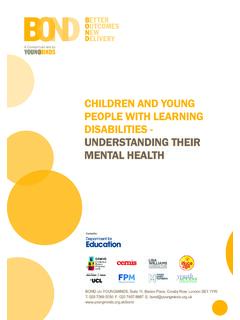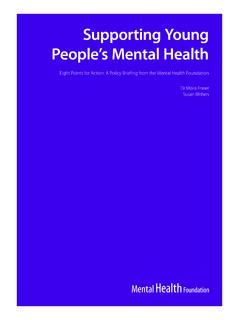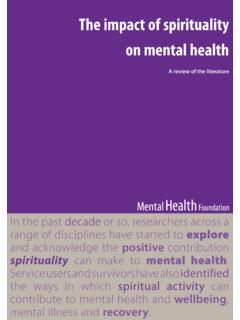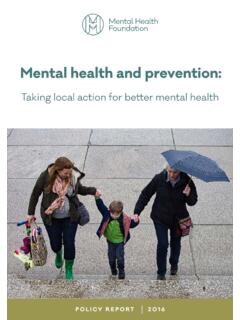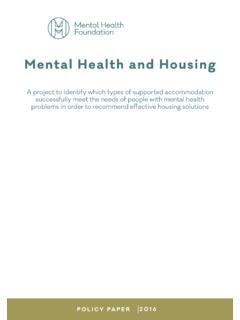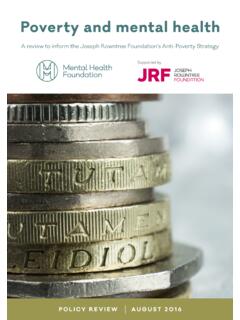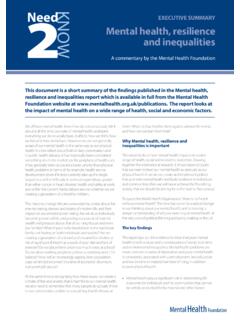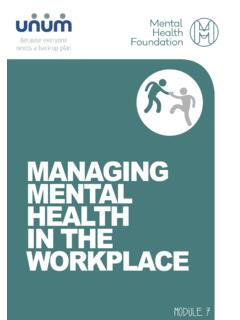Transcription of Supporting Young People’s Mental Health
1 Eight Points for Action: A Policy Briefi ng from the Mental Health FoundationSupporting Young people s Mental HealthDr Moira FraserSusan BlishenAuthors: Dr Moira Fraser Susan BlishenAdditional research: Sally Snowball Justin Pearce-Neudorf Fabien DecodtsWith thanks to the Young people and CAMHS professionals who contributed their views and experiences, and Kathryn Pugh ( Young Minds). AcknowledgementsSupporting Young people s Mental HealthSupporting Young people s Mental Health | 1 IntroductionRates of Mental Health problems reported among children and Young people have risen over the last fi fty years1. Among teenagers, rates of anxiety and depression increased by 70% in the past 25 years2 and the incidence of reported self-harm has also risen, with one in 15 Young people now thought to be aff ected3. Left unresolved, Mental Health problems signifi cantly aff ect children and Young people s social and educational development. This can have a profound and lasting negative impact into adult life in terms of employment, relationships, and likelihood of disability.
2 Paradoxically, the time at which most help is often needed- the period of transition from childhood into adulthood is exactly the time at which services are currently least able to meet that need. This paper outlines key areas for the development of support for Young people and their Mental Health , focusing in particular on adolescence and Young adulthood (the 11-25 age range). Recommendations within this paper are informed by ten years of Mental Health Foundation work on children and Young people s Mental Health , including the Listen Up! project4, which explored ways of providing person-centred support to Young people experiencing Mental Health diffi the Mental Health of Young people mattersGood Mental Health is the foundation of Young people s emotional and intellectual growth, underpinning the development of confi dence, independence and a sense of self worth. Young people who are mentally healthy will have the ability to: Develop psychologically, emotionally, creatively, intellectually and spiritually Initiate, develop and sustain mutually satisfying personal relationships Use and enjoy solitude Become aware of others and empathise with them Play and learn Face problems and setbacks and learn from them5 Enjoy and protect their physical Health Make a successful transition to adulthood in due courseConsequences of poor Mental Health in Young peopleThere is growing evidence that some types of Mental Health problems are predictive of negative outcomes later in life.
3 For example, there is a strong, unfavourable relationship between childhood conduct disorder and social exclusion and poor inter-personal relationships, off ending behaviour and erratic employment6. There is also a strong correlation between child and adolescent Mental Health issues and Mental Health problems in adulthood. In one study 50% of Young adults with a Mental Health problem had been fi rst diagnosed between the ages of 11 and 157. It s easy to hide how I m feeling if I don t feel I can talk to them or that they will understand or provide the right supportYoung personSupporting Young people s Mental Health2 | The economic and social cost of failing to address the emotional problems faced by children and Young people is vast. It is estimated that the costs of public services used through to adulthood by individuals with troubled behaviour as children are 10 times higher than for those with no signifi cant and protective factorsFactors or circumstances associated with the risk of children experiencing Mental Health problems include family structure (such as lone parent, reconstituted families, large families); educational attainment of parents, poverty and low socioeconomic status9.
4 A Mental Health Foundation project identifi ed four groups of Young people as being particularly vulnerable to Mental Health problems. These groups were children with emotional and behavioural diffi culties, homeless Young people , looked after children and Young off enders10. These groups are also less likely to have their problems diagnosed or to receive help to deal with them. Other groups recognised as vulnerable include Young carers, refugees and asylum seekers and Young people with learning is clear that parenting style has a critical impact on children s emotional and cognitive development. Key protective factors include feeling loved, trusted and understood, having interest in life, optimism, autonomy, self-acceptance, and resilience11. In addition, the school environment has been found to play a role. Whole school approaches to Mental Health promotion, and well-evidenced forms of anti-bullying strategies, for example, have been found to be protective of children s Mental Health .
5 Further investment is needed in research to determine which interventions are most eff ective in reducing risk factors and strengthening protective factors, and this research should underpin Young people s Mental Health | 3 Recent Government policy, spearheaded by Every Child Matters12, has placed increased focus on children s wellbeing and promoting Mental Health , with emphasis on early intervention and identifi cation. Local Children and Young people s Plans have been introduced to provide support for more integrated and eff ective services. Strengthening Health promotion in local communities and targeting resources to the neediest communities have been highlighted as priorities. Youth Matters13, the Governments strategy for youth published in March 2006 intends to build on this by empowering Young people in shaping the services they need, encouraging their involvement and Supporting better choices. In addition, it pressed for a single point of contact for Young people experiencing diffi culties.
6 A further ten year strategy - Aiming high for Young people14 was published in July 2007, to promote involvement in positive leisure activities and the development of resilience and social and emotional skills. To integrate services for children, Children s Trusts have been developed, which are supposed to be in place in every local authority by 2008. The process of integrating support and services is to be supported by a common assessment framework, information sharing, a lead professional and common core competencies for those working with substantial policy review of children and Young people , published by HM Treasury and the Department for Education and Skills in 2006, off ered a sophisticated analysis of the factors that contribute towards good Mental Health with the intention of feeding in to the 2007 Comprehensive Spending Review. Building resilience is a major theme and there is a welcome recognition of the importance of good social and emotional skills in helping to protect children and families from poor outcomes later in life.
7 The review also set out a variety of measures and additional investment to improve support for parents and for families trapped in a cycle of low achievement. For services which seek to provide support and care for children and Young people who need to use Mental Health services, either at a universal or specialist level, it was clear that policy levers needed to be set in place to drive development. To address this, the National Service Framework (NSF) for Children, Young people and Maternity services15 was published in 2004, describing the support which children and Young people should expect to be able to receive. Standard 9 of the NSF addressed the Mental Health and psychological wellbeing of children and Young people . It stated that by 2014: All children and Young people from birth to their eighteenth birthday, who have Mental Health problems and disorder have timely access to timely, integrated, high quality, multi disciplinary Mental Health services to ensure eff ective assessment, treatment and support, for them and their families.
8 This meant that all levels - known as tiers - of Child and Adolescent Mental Health Services (CAMHS) services from universal to highly specialist, were in need of signifi cant development. In addition, in 2003, a Public Service Agreement (PSA) was put in place stating comprehensive provision of CAMHS services should be available by 2006. Policy backgroundSupporting Young people s Mental Health4 | Since the PSA and the introduction of the NSF, there has been heavy investment in CAMHS, with expenditure rising by over 80% from 2002/3 to 2005/6. Staffi ng levels have also increased by 27% from 2003 to 200516. However, these increases need to be set against the fact that they started from a low baseline, and a high proportion of children who could benefi t are still not accessing appropriate services. For example, research has shown that only 25 per cent of children with a diagnosed psychiatric disorder were accessing Mental Health services during this period17. Although not all Young people wish to access specialist services and often fi nd support elsewhere, there is a question of whether this is even off ered as an option for many Young people experiencing Mental Health diffi culties.
9 A two-year review of the implementation of Standard 9 was published in 200618 evaluating progress. It focused on three particular proxy targets: 24 hour cover for urgent needs and specialist assessments; CAMHS available to children and Young people with learning disabilities; and services available for all 16 and 17 year olds. All showed signifi cant progress in terms of the proportion of PCTs commissioning these this important time of development of policy for Young people , and a time when CAMHS services are intended to have become comprehensive , it is a good moment to take stock of what has been achieved and what still needs to be Young people s Mental Health | 5 Lots of teenagers seem so mixed up, and a lot of adults can be quite patronising and not be as helpful just because we are Young . I would like to see more youth groups that off er confi dential advice or at least someone to talk PersonDespite the reports of signifi cant progress, there is a question as to whether the reality of services on the ground matches up to the high aspirations of the NSF.
10 Ways need to be found to ensure these aspirations can be met, with special consideration being given to what Young people say they want, what is known to work, and the needs of 16-25 year olds. This will mean a much greater emphasis on the support that is provided in non- Mental Health settings, the places where children and Young people work and play, in primary care, and on enhancing family and peer support. Developing a research and development strategy coupled with knowledge management must be part of the agenda too, as should workforce development. And, critically, more needs to be done to protect the Mental wellbeing of all children and Young people by educating them and those who look after them about the factors that help and hinder Mental Health . Further consideration of the following eight areas is needed as a priority:1. Using CAMHS more eff ectively and shifting responsibility to the mainstreamChild and Adolescent Mental Health services are based around a 4-tier model, ranging from Supporting universal services to providing highly specialist care.
